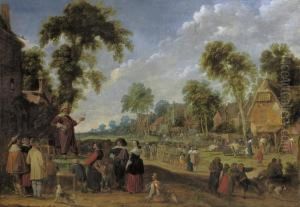Jacob Wijnants Paintings
Jacob Wijnants, often spelled Jacob van Wijnants or Wynants, was a Dutch Golden Age painter who specialized in landscapes. Born in Haarlem in 1635, Wijnants is known for his serene and pastoral landscapes that capture the tranquil countryside of the Netherlands, with particular attention to the effects of light and atmosphere.
Wijnants likely trained in Haarlem, which was a center for Dutch landscape painting in the 17th century. He was influenced by other Dutch landscape painters such as Jan van Goyen, Pieter de Molijn, and particularly by Salomon van Ruysdael. Wijnants' early works show a strong influence from these artists, especially in his use of a monochrome palette and the depiction of expansive skies.
Unlike many of his contemporaries, Wijnants did not include many figures or animals in his landscapes, preferring instead to focus on the interplay of natural elements like trees, water, and sky. His paintings often feature dunes and sandy paths, which were typical of the Dutch countryside, executed with a delicate and precise touch.
Over time, Wijnants developed a more colorful palette and started to include more figures and animals, often painted by other artists. He collaborated with figures such as Johannes Lingelbach, Adriaen van de Velde, and Philips Wouwerman, who would add staffage to his landscapes. These collaborations were common in Dutch Golden Age painting, where specialists in different genres would often work on a single piece.
Throughout his career, Wijnants remained true to the landscape genre and did not venture much into other types of painting. His works were collected by connoisseurs and art lovers across Europe, reflecting the widespread appreciation for Dutch landscape paintings during this period.
Jacob Wijnants died in 1684, leaving behind a body of work that continued to influence landscape painters well into the 18th century. His paintings are characterized by their tranquility and naturalism, and they remain a testament to the enduring appeal of the Dutch landscape in art.
